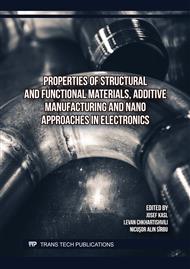p.39
p.47
p.59
p.71
p.83
p.93
p.99
p.107
p.113
Extended Study of High-Energy Irradiation Effect on Majority Current Carriers Mobility in n- and p-Type Silicon Crystals
Abstract:
To understand the kinetics of changes in the majority current carriers Hall mobility temperature-dependency (in the temperature range of 77–300 K) in n- and p-type silicon crystals irradiated with high doses of high-energy particles during isochronous annealing, there are investigated P-doped n-Si samples irradiated with 25 MeV protons with dose of 8.1·1012 cm–2 at flux density of 1.5∙1011 cm–2·s–1 and B-doped p-Si samples irradiated with 8 MeV electrons with dose of 1.0·1015 cm–2 at flux density of 5.0·1012 cm–2·s–1 at room temperature. Their isochronous annealing is performed in the temperature range of 80–500°C. The oscillatory character of the change in the majority current carriers Hall mobility in process of isochronous annealing of irradiated silicon samples is explained by the formation of disordered regions and the changes in degree of screening of their electric field potential barriers depending on charge states of nonequilibrium vacancies induced by irradiation.
Info:
Periodical:
Pages:
107-112
Citation:
Online since:
November 2025
Keywords:
Price:
Сopyright:
© 2025 Trans Tech Publications Ltd. All Rights Reserved
Share:
Citation:


